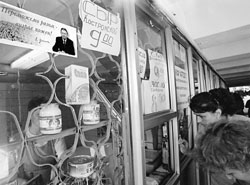Two-thirds of Ukrainians consider their family material circumstances intolerable

Today, every resident of Ukraine has to spend at least UAH 200 ($47) on food monthly, The Day was told by Ph.D. economist Oleksiy Plotnykov. Olena Skrypnyk, head of the Ministry of Labor's living standard and social guarantees department, says the minimum food basket cost 80 hryvnias 88 kopiykas ($17) in July alone. Meanwhile bread, sugar, butter, detergents, etc. are going up in price, and sugar in Kyiv is reaching two hryvnias.
Even the head of the National Bank (its statistics point to 28% of the populace living below the poverty line, meaning they cannot even afford that minimum food basket) spoke last week about price stability. Viktor Yushchenko believes this stability (sic) can be retained next year, provided the hryvnia remains stable and «fiscal and monetary policies are well balanced.» And Ukraine's top banker made another optimistic statement: «There is no tragedy in 2000.» The impression was that Mr. Yushchenko had finally acceded to the correct (in view of the coming October event) forecasts previously characteristically offered by the Minister of the Economy, Premier, and Presidential Administration.
«Making this statement about the stability of prices, Viktor Yushchenko is obviously pursuing a political goal, trying to paint a positive economic picture in Ukraine on the elections eve,» says Dr. Plotnykov.
In the meantime, early in June, the Ministry of Economy promised that the hryvnia rate would not be higher than 4.0 toward the end of the year. Now, early in September, the rate is almost 5.0 at certain currency exchange booths. Another surpassing NBU decision: adjusting the hryvnia's devaluation to changes in consumer prices. Under a backward economy, price jumps are not the reason for but consequence of devaluation, Dr. Plotnykov insists.
The «stable hryvnia» responded to the chief banker's statement immediately, reaching out of the currency trade band on the interbank currency market Wednesday (UAH 3.4-4.6), averaging 4.62 hryvnias per dollar. Our bankers have long talked about surplus hryvnia stock at ICM, foretelling a dollar sale boom. It means that the hryvnia's continuous devaluation will continue to lower the living standard and buying capacity of the populace (as it is, the populace's incomes have long fallen far apart from food expenses, even at the lowest consumption level). Accordingly, one cannot but feel very dubious about the stability of prices now, let alone next year.
INCIDENTALY:
SOCIS polled 2,400 persons in August. A mere 1% stated their family budget status was above the average; 19% said it was average; 17% regarded it as below the average, and 63% claimed it was low and extremely low.
Newspaper output №: Section






